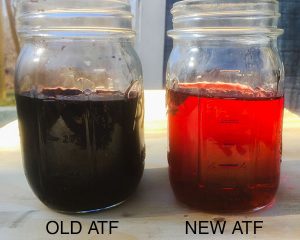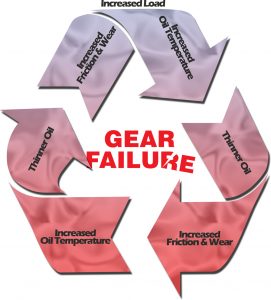Casual motorists generally take no interest in crawling under their vehicles on a Saturday afternoon. And, when was the last time you heard someone express excitement over dropping their car off at the dealership for maintenance?
The automakers know this, which explains the proliferation of sealed, or filled-for-life, transmissions and differentials. Many vehicles also use “lifetime” fluids in these components that supposedly don’t require changing. Some transmissions and differentials don’t even include dipsticks or access plugs for checking the fluids.
The dirty little secret is that “filled-for-life” really means “filled for the life of the warranty.”
Suppose the “filled-for-life” transmission or differential on your truck fails after the factory warranty has expired. What do you think the dealership is going to do? That’s right – slide a bill across the counter to the tune of several thousand dollars.
It’s a good idea to change fluids in a filled-for-life or sealed transmission or differential at least once during its lifetime, and more often if you tow or haul.
Here’s why.
Big power = increased heat
Modern vehicles are tougher on transmission fluid and gear lube than ever.
For starters, the automakers are in an endless arms race to produce more power than the competition. All that added power has to go through the transmission and differential before reaching the wheels, yet modern transmissions are smaller and lighter than their predecessors. Meanwhile, the gears and bearings in most differentials remain unchanged despite the increased power they must handle.
This adds up to increased heat, and heat is one of the transmission fluid’s biggest enemies. It speeds the oxidation process and causes the fluid to chemically break down.
Fluid that has broken down can cause sludge and varnish to form, which clogs narrow oil passages and can lead to stuck valves. Soon, your vehicle can begin to shift hard, hesitate or quit shifting altogether.
The situation is just as dire downstream of the tranny where heat and pressure wreak havoc inside the differential. Towing and hauling increase friction, which in turn increases heat. Extreme heat causes the gear lube to thin, reducing the effectiveness with which it keeps gear teeth separated and prevents wear. Thinner gear lube further increases friction, which causes heat to increase in a vicious cycle known as “thermal runaway.”
Lighter fluid, and less of it
Components also use lower-viscosity fluids to help boost fuel efficiency. That translates into thinner fluid protecting against intense heat and wear – not an easy task.
In addition, many automakers use less gear lube than before to help reduce energy lost to friction and boost fuel economy.
Given such challenging conditions, what’s the best way to combat heat and stress to ensure your vehicle keeps running strong? Never change the fluids? Hardly.
“Filled-for-life” is misleading
In fact, your “lifetime” fluid may require changing if your driving habits fall under the “severe” designation, which includes towing and hauling.
The differential in the 2016 Ford Super Duty 250, for example, is considered “filled for life.” However, the owner’s manual instructs you to change the fluid every 50,000 miles (80,467 km) in “severe” conditions and anytime the differential is submerged in water.
Did you hear that, anglers?
The 2017 Toyota Tundra likewise features a “filled-for-life” differential. But Toyota tells you to change fluid every 15,000 miles (24,140 km) if towing.
Complicating matters, some vehicles don’t even include a service schedule for changing transmission fluid. The Mazda CX-5 is one example. That doesn’t seem like a great idea if you plan to keep the vehicle past its factory warranty period.
For maximum life and best performance, change the “lifetime” fluid in your vehicle’s filled-for-life or sealed transmission or differential at least once, but more often if your driving conditions fall under the severe designation.
Changing fluid in these units may tax one’s mechanical aptitude, but it can be done. You likely need to visit the dealer or a mechanic since special tools can be required. Some manufacturers also prescribe complicated procedures spelled out in a service manual for changing fluids.
Anyone who has changed gear lube before – whether on a “filled-for-life” differential or traditional unit – knows the hassle involved: a tough-to-reach fill hole, gear lube spilled everywhere and bloody knuckles.
Find out how often to change gear lube here.
Our SEVERE GEAR easy-pack offers the perfect solution. Compared to rigid conical bottles that waste a quarter of the gear lube or more, our easy-pack offers the dexterity to maneuver around vehicle components and the flexibility to install nearly every drop of gear lube. It eases the process of changing gear lube, saving you time and hassle.







Agree 100%! Changed trans and differential fluids at 75,000 on my 2013 Expedition. Both were brown and “burnt”. After change, MPG increased by 1.5 on average….
Lifetime fills absolutely last the life of the transmission; when the fluid fails, so does the transmission!!
I have a 2010 Ford Edge AWD and I didn’t know until I went to check the transmission fluid that it was a sealed unit. I had to go the dealer and they checked it to find it was two quarts low which is why it was slipping. I told them to make sure the trans is OK, and change the fluid, we all know that trans fluid will not last for many years, nothing is lifetime in this world today.
Moral: Always check and change your Transmission fluid, it is cheaper than changing your trans for a new one.
Using Amsoil ATF, my 1998 Dodge Dakota transmission went 623,000 miles.
It was mechanically sound when I sold it. How do I know? Oil Analyzers analyzed the fluid.
I also have a 2010 Ford Edge awd, there is a drain plug on the transmission. I’m currently at 110k miles and simply drain what I can and refill with amsoil Atf, usually just under 6 quarts will come out, I’m going to do this drain & fill procedure three times because it is impossible to fully drain the fluid out of the torque converter, eventually will be 90% new amsoil atf fluid in there. The transmission was shifting really smooth after the first time putting the amsoil in, gets better every drain n fill there after. If your Edge is the awd system I highly suggest you get a change out on your PTU (power transfer unit) with some amsoil severe gear 75-140W, that is another ford “fluid for life” joke, I actually drilled my own drain plug in it to make the fluid changes easier.
How does a person like myself change transmission fluid on a Toyota that has a seal transmission and it is done with special equipment. I have always change my transmission fluid but it can not be done on some transmissions unless one has special equipment, Toyota is one of these care’s. I know if brought to a car dealer they may tell you they change your fluid by no dipstick, no way to prove the work was done.
Hi Robert,
You’ll have to take your vehicle to the dealership or a transmission shop. As far as ensuring the work is actually performed, a certain level of trust is implied. Use a transmission shop that comes recommended by a friend or other person you trust. Ask the manager if you can see the old fluid after it’s changed. Most independent shops deliver the best service possible to ensure their survival in a competitive industry.
Good luck,
John
When switching to Amsoil atf in a Allison Duramax transmission is it ok to just change the filter and fluid and mix the atf that’s in the torque converter
Hi Milton,
While a complete tranny flush is optimum, there are no issues with draining the fluid, replacing the filter and topping off with the appropriate AMSOIL transmission fluid for your application.
Thanks,
John
I didn’t know that you needed to get your transmission fluid changed. My transmission is making weird noises. I’ll have to look into finding the best auto service to check it out.
Transmission fluid is nothing but kind of a lubricant which reduces friction among the adjacent components of the transmission and any sign which indicates that the transmission has some sort of mechanical issues shouldn’t be ignored as such kinds of arrogance could cost a lot. The lubricant used in the transmission loses its lubrication ability after a certain time interval. So, it is really essential to inspect the quality of the transmission lubricant after a certain time interval. Burned transmission fluid needs to be replaced after a certain time interval to keep the transmission in working order.
I been wanting to change my fluid since I bought the car it shifts smooth and no problems but I’m scared since it has 160k miles
So what scares you ?
Cleaning the pan – if it has one.
Putting in a new filter – if it has one.
and changing the fluid –
Decreases the chances of having heat related clutch plate scoring.
Not changing the fluid – is a scary thing.
Not the best choice to make.
Maybe you should should change 1 quart at every engine oil change. Then, each quart slowly dilutes the dirty fluid, as its detergents do their job.
I’ve been doing 1 quart, every other oil change, and my Honda shifts perfect, looks clean, and has a crapload of miles on it.
If the color of the transmission fluid is blackish then it should be replaced immediately with suitable substitutes. The quality of the lubricant used in the transmission has significant impacts on its performance. Lack of adequate amount of transmission lubricant or use of burnt lubricant in the transmission could affect the performance of the vehicle in a very adverse way. So, the condition of different components along with different types of lubricants used in the vehicle should be subjected to inspection and burnt lubricants should be replaced with suitable substitutes.
In theory that’s true, however it’s a strong possibly that new ATF with the new additives (detergents) might “wash” away the remaining clutch and band material in an high mileage/old transmission and soon after servicing the trans it starts slipping and then its truly toast!
This is my first time pay a visit at here and i am actually happy to read all
at single place.
My transmission fluid gets replaced every time the transmission gets replaced. No problem!
HAHA our 98 2500HD has a little over 200,000 miles on it now with the original fluid still in it. It has towed and plowed snow its entire life as well lol. I wouldn’t DARE change it at this point that is for sure. Good bye transmission!
Changed the Transmission Fluid on my Wife’s 2014 Ford Focus. It shifts smoothe enough now that we can’t feel it, and we are getting 3-4mpg better mileage (45-49).
I change the transmission fluid in all our vehicles once a year.
I have a 2007 Ford Edge awd. The PTU in these cars is weak, you need to change it. I’m also on my 3rd PTU, only holds about 12 oz of gear oil. I change it every year & that hasn’t been enough, 3 PTU’s in 220,000 miles is a joke!
How often does a highlander 2017 hybrid that tows 2500 lb trailer 10% of the time need its cvt transmission oil changed?
Hi James,
Check the owner’s manual for service recommendations.
Thanks,
John
James, cvt still every 100k. Same with the rear hybrid MGR drive system fluid.
2014 Ford Flex with four wheel drive. Any Ford All Wheel Drive owner should have the “right angle” gearbox to the rear of the vehicle checked and the fluid replace before the warranty goes out.
A new gearbox is 800 or so on the net and difficult to replace if it goes out. Ours at 80K miles started to leave a black stain on the driveway. This gearbox has less then a quart of lube in it.
Bought a 2010 Dodge Ram 1500 Laramie 4×4 new. It’s been a fantastic truck. One thing people may not be aware of is that the fluid in the electronically-shifted transfer case takes a special oil, which is BLUE in color. I believe it’s called Auto Trak. $20/qt! When I drained the case to change oil, it was green (blue+red=green). The quick lube outfits will just put ATF in it, so beware!
What do you recommend for chevy Silverado with the 8 speed trans It is slow shifts when cold and sometimes jerky
Hi Robert,
We need more info to provide product recommendations. The fastest way to find the right AMSOIL products for your truck is to use our Product Guide.
Thanks,
John
I have a 2010 Volvo V-70 3.2 wagon with 210,000 miles on it. The transmission has never been serviced. Do you still recommend changing. I don’t want to stir up a new problem. Thank you for your advice.
Hi John,
Start by looking in your owner’s manual. Volvo probably recommends changing transmission fluid once you hit a prescribed mileage or time limit. Also consider calling the dealership to see what they recommend. If the transmission has a dipstick, check the fluid to gauge condition. If it’s black and smells burned, it’s eventually going to cause a problem.
Personally, I’d change the fluid unless the dealership specifically warns against it.
Thanks,
John
You see posts like this should be in mass media, since its post on oil manufacturers website most peoe would assume it’s not true, very sadly even toyota started making life harder in maintaining your vehicle so it doesn’t last for 20-30 years, they want to sell you new car every 5 – 10 years it is exactly how long it takes for transmission go bad if you never change oil in it. Right to repair should be supported and accepted on the government level.
I’m an auto enthusiast, certified mechanic, and a guy who always keeps his car maintained before schedule.
I Still change oil in sealed transmissions but its so hard to do because it involves expensive equipment
I had a bad experience in one of this Automotive transmission shops. I went for a fluid replacement they said there is metal shavings in the pan and offered me a rebuilt transmission with lifetime warranty. I won’t mention the shop name and just opted for the fluid change and I had no problem after . Some transmission shops will rip you blind.